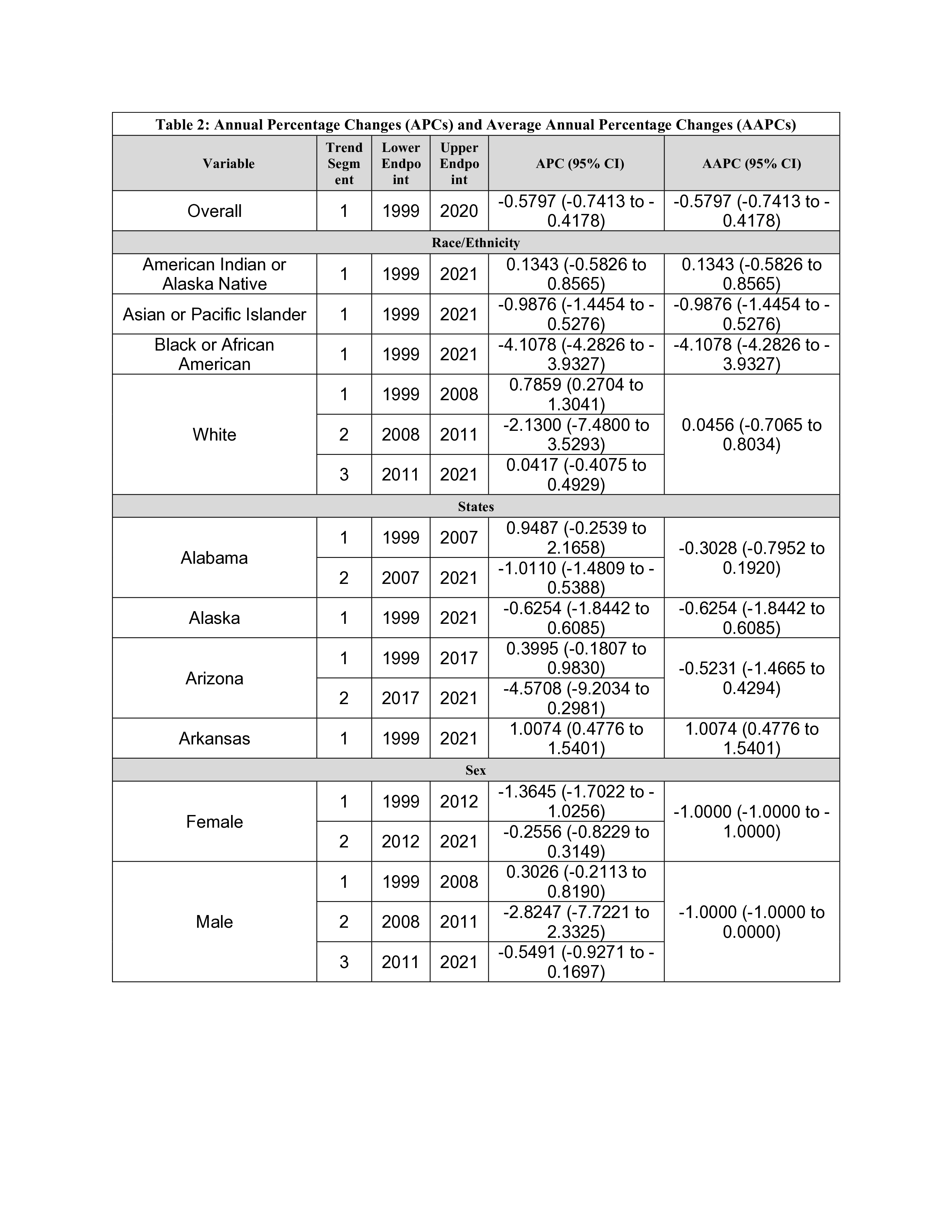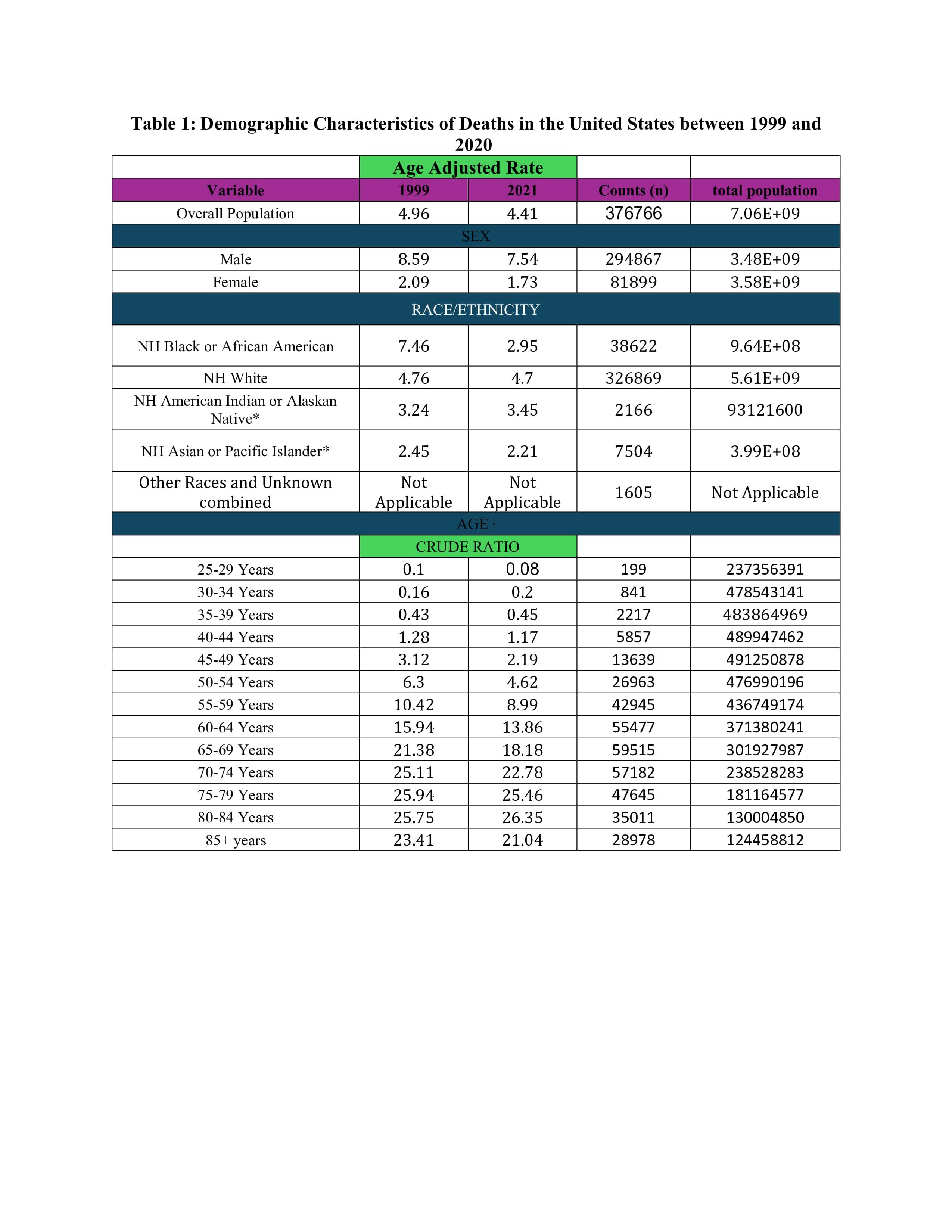Sunday Poster Session
Category: Esophagus
P0639 - Esophageal Cancer Incidence in the United States (1999-2021)
Sunday, October 26, 2025
3:30 PM - 7:00 PM PDT
Location: Exhibit Hall

Tooba Laeeq, MD (she/her/hers)
Kirk Kerkorian School of Medicine at the University of Nevada Las Vegas
Las Vegas, NV
Presenting Author(s)
Tooba Laeeq, MD1, Muzamil Khan, MBBS2, Ayesha Cheema, MBBS3, Wajdan Ahmad, MBBS3, Divij K. Jha, MD4, Swetha Balaji, MD5, Vinod Nookala, MD5, Khadija Mohib, MD1
1Kirk Kerkorian School of Medicine at the University of Nevada Las Vegas, Las Vegas, NV; 2George Washington University, Niles, IL; 3Al-Tibri Medical College, Karachi, Sindh, Pakistan; 4University of Michigan Health - Sparrow, Lansing, MI; 5Saint Clare's Health, New York Medical College, Denville, NJ
Introduction: Esophageal cancer remains a significant public health concern in the United States, marked by high incidence and notable disparities across age, sex, and racial/ethnic groups. While national rates have shown modest declines, the burden remains unevenly distributed across different populations. This study investigates trends in esophageal cancer incidence from 1999 to 2021, highlighting persistent disparities and informing targeted interventions.
Methods: Data were extracted from the United States and Puerto Rico Cancer Statistics (1999–2021) by state and year for esophageal cancer. Age-adjusted incidence rates (AARs) per 100,000 were calculated using the 2000 U.S. standard population. Trends by sex, race/ethnicity, age, and state were analyzed using the Joinpoint Regression Program (version 5.3) to estimate Annual Percent Change (APC) and Average Annual Percent Change (AAPC) with 95% confidence intervals (CIs). Statistical significance was defined as p < 0.05.
Results: Between 1999 and 2021, 376,766 cases of esophageal cancer were reported in the U.S. The overall AAR declined from 4.96 to 4.41 per 100,000. In 1999, non-Hispanic Black individuals had the highest AAR (7.46), while non-Hispanic Asians had the lowest (2.45). By 2021, non-Hispanic Whites had the highest AAR (4.70), and Asians remained the lowest (2.21). Males consistently had the highest AARs (1999: 8.59; 2021: 7.54), and females the lowest (1999: 2.09; 2021: 1.73). The most significant racial decline was observed in Black populations (AAPC: −4.11; 95% CI: −4.28 to −3.93; p < 0.05), while Asian or Pacific Islanders showed the least significant improvement (AAPC: −0.98; 95% CI: −1.44 to −0.53). Females showed greater improvement than males (AAPC: −1.00; 95% CI: −1.00 to −1.00 vs. −1.00; 95% CI: −1.00 to 0.00). Among states, Arkansas was the only one with a significant increase in incidence (AAPC: +1.01; 95% CI: 0.48-1.54). Crude rates were lowest in the 25–29 age group (1999: 0.10; 2021: 0.08) and highest in the 75–79 age group (1999: 25.94) and 80–84 age group (2021: 26.35).
Discussion: Although the overall incidence of esophageal cancer declined from 1999 to 2021, persistent disparities by race, sex, age, and state reveal unequal progress. Black populations saw the greatest gains, yet men, older adults, and states like Arkansas remain disproportionately affected. Focused public health efforts are critical to closing these gaps.

Figure: Table 1: Demographic Characteristics of Deaths in the United States between 1999 and 2020

Figure: Table 2: Annual Percentage Changes (APCs) and Average Annual Percentage Changes (AAPCs)
Disclosures:
Tooba Laeeq indicated no relevant financial relationships.
Muzamil Khan indicated no relevant financial relationships.
Ayesha Cheema indicated no relevant financial relationships.
Wajdan Ahmad indicated no relevant financial relationships.
Divij Jha indicated no relevant financial relationships.
Swetha Balaji indicated no relevant financial relationships.
Vinod Nookala indicated no relevant financial relationships.
Khadija Mohib indicated no relevant financial relationships.
Tooba Laeeq, MD1, Muzamil Khan, MBBS2, Ayesha Cheema, MBBS3, Wajdan Ahmad, MBBS3, Divij K. Jha, MD4, Swetha Balaji, MD5, Vinod Nookala, MD5, Khadija Mohib, MD1. P0639 - Esophageal Cancer Incidence in the United States (1999-2021), ACG 2025 Annual Scientific Meeting Abstracts. Phoenix, AZ: American College of Gastroenterology.
1Kirk Kerkorian School of Medicine at the University of Nevada Las Vegas, Las Vegas, NV; 2George Washington University, Niles, IL; 3Al-Tibri Medical College, Karachi, Sindh, Pakistan; 4University of Michigan Health - Sparrow, Lansing, MI; 5Saint Clare's Health, New York Medical College, Denville, NJ
Introduction: Esophageal cancer remains a significant public health concern in the United States, marked by high incidence and notable disparities across age, sex, and racial/ethnic groups. While national rates have shown modest declines, the burden remains unevenly distributed across different populations. This study investigates trends in esophageal cancer incidence from 1999 to 2021, highlighting persistent disparities and informing targeted interventions.
Methods: Data were extracted from the United States and Puerto Rico Cancer Statistics (1999–2021) by state and year for esophageal cancer. Age-adjusted incidence rates (AARs) per 100,000 were calculated using the 2000 U.S. standard population. Trends by sex, race/ethnicity, age, and state were analyzed using the Joinpoint Regression Program (version 5.3) to estimate Annual Percent Change (APC) and Average Annual Percent Change (AAPC) with 95% confidence intervals (CIs). Statistical significance was defined as p < 0.05.
Results: Between 1999 and 2021, 376,766 cases of esophageal cancer were reported in the U.S. The overall AAR declined from 4.96 to 4.41 per 100,000. In 1999, non-Hispanic Black individuals had the highest AAR (7.46), while non-Hispanic Asians had the lowest (2.45). By 2021, non-Hispanic Whites had the highest AAR (4.70), and Asians remained the lowest (2.21). Males consistently had the highest AARs (1999: 8.59; 2021: 7.54), and females the lowest (1999: 2.09; 2021: 1.73). The most significant racial decline was observed in Black populations (AAPC: −4.11; 95% CI: −4.28 to −3.93; p < 0.05), while Asian or Pacific Islanders showed the least significant improvement (AAPC: −0.98; 95% CI: −1.44 to −0.53). Females showed greater improvement than males (AAPC: −1.00; 95% CI: −1.00 to −1.00 vs. −1.00; 95% CI: −1.00 to 0.00). Among states, Arkansas was the only one with a significant increase in incidence (AAPC: +1.01; 95% CI: 0.48-1.54). Crude rates were lowest in the 25–29 age group (1999: 0.10; 2021: 0.08) and highest in the 75–79 age group (1999: 25.94) and 80–84 age group (2021: 26.35).
Discussion: Although the overall incidence of esophageal cancer declined from 1999 to 2021, persistent disparities by race, sex, age, and state reveal unequal progress. Black populations saw the greatest gains, yet men, older adults, and states like Arkansas remain disproportionately affected. Focused public health efforts are critical to closing these gaps.

Figure: Table 1: Demographic Characteristics of Deaths in the United States between 1999 and 2020

Figure: Table 2: Annual Percentage Changes (APCs) and Average Annual Percentage Changes (AAPCs)
Disclosures:
Tooba Laeeq indicated no relevant financial relationships.
Muzamil Khan indicated no relevant financial relationships.
Ayesha Cheema indicated no relevant financial relationships.
Wajdan Ahmad indicated no relevant financial relationships.
Divij Jha indicated no relevant financial relationships.
Swetha Balaji indicated no relevant financial relationships.
Vinod Nookala indicated no relevant financial relationships.
Khadija Mohib indicated no relevant financial relationships.
Tooba Laeeq, MD1, Muzamil Khan, MBBS2, Ayesha Cheema, MBBS3, Wajdan Ahmad, MBBS3, Divij K. Jha, MD4, Swetha Balaji, MD5, Vinod Nookala, MD5, Khadija Mohib, MD1. P0639 - Esophageal Cancer Incidence in the United States (1999-2021), ACG 2025 Annual Scientific Meeting Abstracts. Phoenix, AZ: American College of Gastroenterology.
